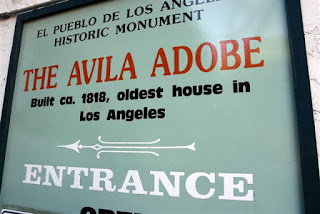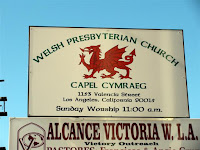Sunday, November 15th, 2009
On a sunny morning a group of about 50 members of Temple Aliyah (of Woodland Hills), led by my son-in-law Rabbi Gary Oren and Jeremy Sunderland, participated in a “Jewish Heritage Tour of Greater Los Angeles”.
A tour bus was waiting in front of the temple, and around 9:30 we started this amazing day of discovery.



During the 45 minutes drive to Boyle Heights, our first stop of the tour, Jeremy gave us a short summary and revealed some interesting facts about the first Jews in Los Angeles:
According to records, Jacob Frankfort, a German tailor was perhaps the first Jew to arrive in Los Angeles in 1841. In 1850, California was admitted to the Union and the U.S. Census recorded 8 Jews residing in Los Angeles County. One of them, a fellow named Morris L. Goodman, was on the first Common Council of the city. The founding of Beth-El Congregation was held in 1861 and a year later the first kosher meat market was opened. In 1865, Louis Lewin, the printer, and Charles Jacoby organized the Pioneer Lot Association, which developed the area later known as Boyle Heights (named after former owner Andrew Boyle). In 1870, Federal Census lists Los Angeles total population of 5,728 of which there were 330 Jewish individuals in the city or 5.76% of the total population. In the mid-1890's, a small proportion of Eastern European Jews began what became an influx of new settlers from the mid-west.
Between 1900 and 1926, 2500 Jews lived "downtown," which in 1910 was described as Temple Street (the main Jewish Street) and the area to its south. Smaller groups lived in the University, Westlake, and the Wholesale areas. Except for University, these areas steadily declined between those years.
In the 1920’s, significant numbers of Jewish immigrants and their families, drawn by the economic boom and warm and dry weather, moved to Los Angeles from East Coast and mid-west cities, eventually making Boyle Heights home to the largest Jewish community west of Chicago. Boyle Heights contained the Hebrew Sheltering Home, the Talmud Torah, the Modern Social Center, the Day Nursery and the area around the Breed Street Synagogue (Congregation Talmud Torah).
Boyle Heights had 70,000-80,000 Jews from the 1910's through the 1950's
Since the late 1980’s, the City of Los Angeles has been home to the world’s second largest Jewish population. Only the City of New York could boast of a larger Jewish population. It is estimated that approximately 600,000 Jews live today (2008 Census) in the Greater Los Angeles area.
(Note: This number is probably much higher as it depends only on Jews registering in any Synagogues or the Jewish National Fund).
Since the late 1980’s, the City of Los Angeles has been home to the world’s second largest Jewish population. Only the City of New York could boast of a larger Jewish population. It is estimated that approximately 600,000 Jews live today (2008 Census) in the Greater Los Angeles area.
(Note: This number is probably much higher as it depends only on Jews registering in any Synagogues or the Jewish National Fund).
Our first stop of the tour was at Boyle Heights. We passed through Hollenbeck Park (alongside the 110 Freeway), where in the old days many Jews used to spend time with their families, and then we passed Roosevelt High School on Mathews St (established in 1923).
We proceeded to our first stop of the tour: The Breed Street Synagogue, also known as Congregation Talmud Torah of Los Angeles.

We met another group, which came from Pasadena. They were actually waiting for us, as Jeremy had the key to enter the site, which is under heavy constructions to repair and renovate this Orthodox Jewish synagogue that was once the largest Orthodox synagogue in the western United States from 1915 to 1951 and is listed in the National Register of Historic Places.
As we entered this historic building, I was overwhelmed by the beauty it once possessed and by the destruction it has encountered during years of neglect and vandalism. Jeremy stood on the “Bimma” and gave us all a brief description of the place and its history:
Congregation Talmud Torah began in Downtown Los Angeles in 1904, but moved to Boyle Heights in 1913 as large numbers of Jews settled there. In 1915, a wood-framed building was dedicated for use as a school and chapel and became known as the "Breed Street Shul." The wood-frame building was moved to the rear of the property and the imposing brick structure was dedicated in 1923.
The area around Breed Street Shul became a center for the Jewish community. The business district on Brooklyn Avenue (renamed Cesar Chavez Avenue in 1995) just north of the Shul was the location of many kosher butchers, bakeries, delis (original Canter’s Deli was there!), bookstores and other shops catering to the Jewish community. The Breed Street block where the Shul was located also became home of the Los Angeles Jewish Academy and Mount Sinai Clinic (a forerunner of Cedars-Sinai Medical Center).
In 1998, then-First Lady Hillary Clinton visited the Shul as part of her Save America's Treasures campaign. The building fell into disrepair in the 1990s, so the City of Los Angeles foreclosed on the property after recording an assessment for barricading and protection. In July 2000, the City quitclaimed the property to Breed Street Shul Project, Inc., a subsidiary of the Jewish Historical Society of Southern California. The organization plans to rehabilitate the buildings as a county museum, educational and cultural center.
I was mesmerized when I looked around the building as evidence of once a flourishing center for the Jewish community became so miserable in its condition. Burnt Holy Books, broken Menorah, rusted “Pishka”, graffiti all around along with broken doors, windows, and benches made their impression. On the walls around the main hall, the Hebrew Zodiac signs decorated with beautiful pictures are in a pretty good shape, but all the other paintings on the walls were in a very bad shape.

We spent about an hour listening to Jeremy and looking around as if to discover something that had not been found yet and then exited back to Breed Street and then went around the block, using Soto Street, to Cesar Chavez Avenue where there are still some signs of what once used to be Brooklyn Avenue.




Back on the bus, we passed yet another church that used to be a synagogue (Fairmount Street Shul) and the Jewish symbols were still present on the street side of the building and then we passed the former Menorah Center, the former Schvitz, and the former home of the Jewish Home for the Aged.
=============================================================================================================================================================
Then we crossed one of the bridges and arrived in the Downtown area where we had our lunch (Kosher of course) at La Placita, where a group of South American danced away in their native customs.



We then toured Olvera Street, where Los Angeles was founded and the first building of Los Angeles is still standing there today.
=============================================================================================================================================================




We were back on the bus an hour later and continued our tour.

Our next stop was at Welsh Presbyterian Church on Valencia Street.
 This used to be The Sinai Congregation Synagogue, built in 1909, after a rift between the city’s Orthodox Jews. The synagogue opened without its permanent seats. Once they were installed, the building held about 400 worshippers on the main floor and about 200 in the gallery (“Ezrat Nashim”). In 1925, when the Sinai congregation moved to its new home on South New Hampshire, the building was sold to the Welsh Presbyterian Church. Inside we saw the Stars of David displayed in the building, in the stained glass windows and the ceiling medallion.
This used to be The Sinai Congregation Synagogue, built in 1909, after a rift between the city’s Orthodox Jews. The synagogue opened without its permanent seats. Once they were installed, the building held about 400 worshippers on the main floor and about 200 in the gallery (“Ezrat Nashim”). In 1925, when the Sinai congregation moved to its new home on South New Hampshire, the building was sold to the Welsh Presbyterian Church. Inside we saw the Stars of David displayed in the building, in the stained glass windows and the ceiling medallion.=============================================================================================================================================================




We were back on the bus and a few minutes later passed a house on Carroll Avenue, which was used in the early 1900’s as a hospital for those who had tuberculosis. The Kaspare Cohn Hospital was originally planned as a sanitarium for tubercular patients; it became a general hospital when city ordinances forbade the treatment of tuberculosis victims within the city limits.

We continued our bus tour and arrived to Chavez Ravine, home of the Los Angeles Dodgers and then stopped at a place known to be the site of the first Jewish cemetery in Los Angeles (Founded in 1855). It was moved to its current location (Home of Peace Cemetery) in 1902. The remains of the 360 Jews buried in the old cemetery were moved between 1902 and 1910.
=============================================================================================================================================================

Our tour continued, as we arrived at Wilshire Blvd to visit the beautiful Wilshire Boulevard Temple, which was founded in 1862 as Congregation B’nai B’rith and is the oldest surviving Jewish congregation in Los Angeles. Inside the complex we walked through the hallway and looked at some displays, summarizing in words and pictures the history of this place.
=============================================================================================================================================================


We entered the main room and were captivated how high the ceiling is. Jeremy took center stage and told us few facts about the temple and its history:






The Temple is one of the country’s most respected Reform congregations.
=============================================================================================================================================================
The magnificent sanctuary, with its iconic dome and murals, painted by the talented Hugo Ballin, has the only depiction of human images in any synagogue in the world, and is listed on the National Register of Historic Places. Around the walls are pictures representing key moments of the Jewish History. It can seat about 2,000 congregants. Both flags of Israel and the USA are present. Jeremy told us that the State of California flag was replaced by the Israeli flag during the scud bombings of Israel during the Persian Gulf War.
The time was already around 3:00 PM and it was time to get back to Woodland Hills.






























ReplyDeleteGreat blog! I'm glad to see such an amazing chronicle of family events!
David Natalizia
ReplyDeleteGreat Job Abba, you really captured the trip we took and the pictures of the Breed St. Shul are great! love ya,
Gary
Thank you for sharing your experience, I had no idea that such old synagogues were existing
ReplyDeleteUri
Aviram my good childhood friend, your passion to travel and expand your mind with interesting places on this planet, continues to burn. It's a pleasure to join in your discoveries through this wonderful blog. Don't stop and thank you for this discovery.
ReplyDeleteShony